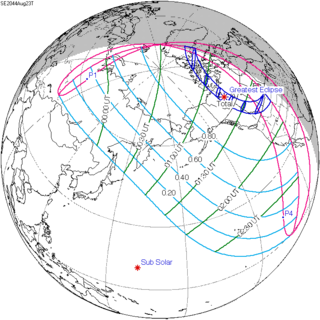
Summary
A total solar eclipse will occur on Monday, August 22, 2068 (eastern for most of the eclipse by UTC timing). A solar eclipse occurs when the Moon passes between Earth and the Sun, thereby totally or partly obscuring the image of the Sun for a viewer on Earth. A total solar eclipse occurs when the Moon's apparent diameter is larger than the Sun's, blocking all direct sunlight, turning day into darkness. Totality occurs in a narrow path across Earth's surface, with the partial solar eclipse visible over a surrounding region thousands of miles wide.
| Solar eclipse of August 23, 2044 | |
|---|---|
 Map | |
| Type of eclipse | |
| Nature | Total |
| Gamma | 0.9613 |
| Magnitude | 1.0364 |
| Maximum eclipse | |
| Duration | 124 s (2 min 4 s) |
| Coordinates | 64°18′N 120°24′W / 64.3°N 120.4°W |
| Max. width of band | 453 km (281 mi) |
| Times (UTC) | |
| Greatest eclipse | 1:17:02 |
| References | |
| Saros | 126 (49 of 72) |
| Catalog # (SE5000) | 9606 |
Path edit
Totality will be visible in the evening of August 22 across:[1]
- Northwestern Greenland
- In Canada:
- Northern and western Nunavut
- Central Northwest Territories
- Extreme southeast Yukon
- Eastern British Columbia, including Dawson Creek and Fernie
- Much of Alberta including Edmonton, Calgary, and Lethbridge
- Extreme southern Saskatchewan, including Swift Current
- In the United States:
- The northeastern half of Montana. Glacier National Park and Great Falls will be just inside the path of totality.
- Western North Dakota, including Williston, Minot, and Dickinson
- Extreme northwest South Dakota
Partiality will be visible in Siberia in the morning of August 23, and throughout western Canada and United States until sunset on August 22.
The greatest duration of the total eclipse will be observed in the Northwest Territories, approximately 60 miles (97 km) southeast of Great Bear Lake.[2]
This is the last of 41 umbral solar eclipses (annular, total or hybrid) of Solar Saros 126. The first umbral was in 1323 and last will be in 2044. The total duration is 721 years.
Images edit
Animated path
Related eclipses edit
The eclipse is a member of a semester series of solar eclipses that repeat approximately every 177 days and 4 hours (a semester) at alternating nodes of the Moon's orbit.[3] It is also part of Saros cycle 126, repeating every 18 years, 11 days, containing 71 events.
References edit
- ^ "Total Solar Eclipse on August 22–23, 2044: Path Map and Times". www.timeanddate.com. Retrieved 2024-03-23.
- ^ "Greatest Duration of Total Solar Eclipse of 2044 Aug 23". NASA Eclipse Website. NASA. Retrieved 9 September 2017.
- ^ van Gent, R.H. "Solar- and Lunar-Eclipse Predictions from Antiquity to the Present". A Catalogue of Eclipse Cycles. Utrecht University. Archived from the original on September 7, 2019. Retrieved 6 October 2018.
External links edit
- http://eclipse.gsfc.nasa.gov/SEplot/SEplot2001/SE2044Aug23T.GIF


